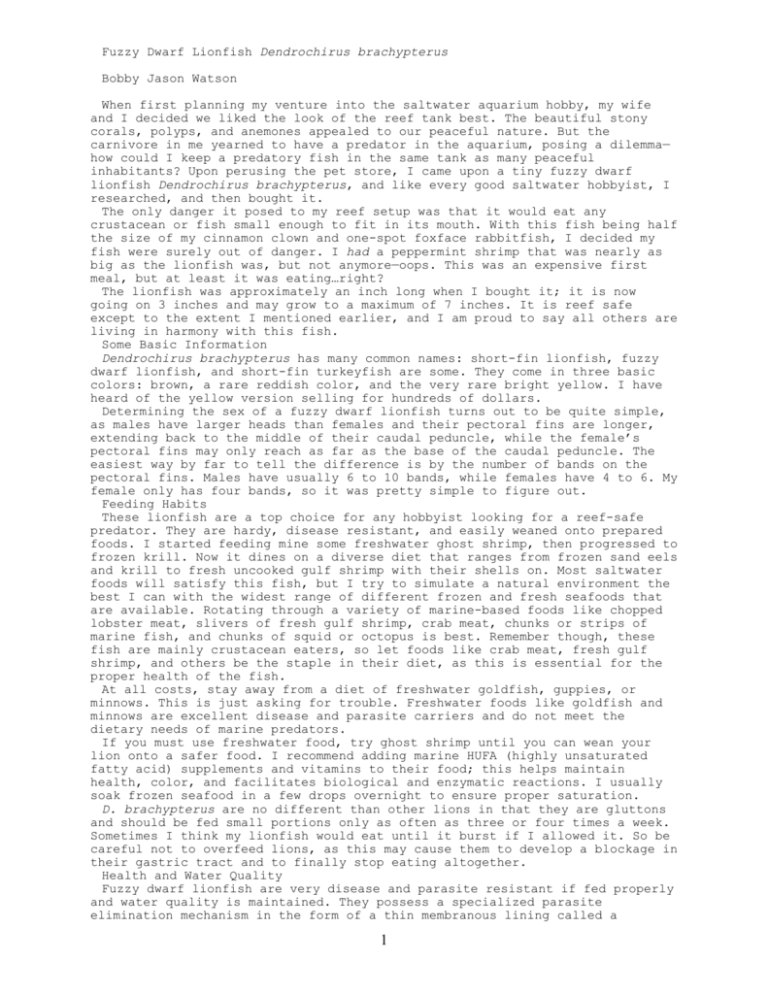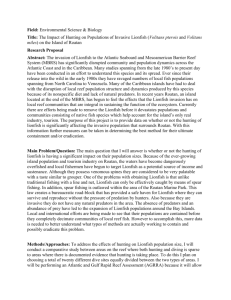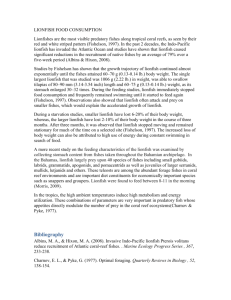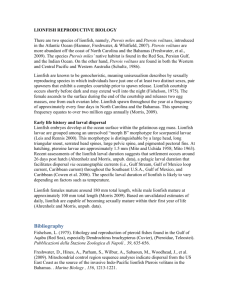Inspiration from TFH Captions T0902
advertisement

Fuzzy Dwarf Lionfish Dendrochirus brachypterus Bobby Jason Watson When first planning my venture into the saltwater aquarium hobby, my wife and I decided we liked the look of the reef tank best. The beautiful stony corals, polyps, and anemones appealed to our peaceful nature. But the carnivore in me yearned to have a predator in the aquarium, posing a dilemma— how could I keep a predatory fish in the same tank as many peaceful inhabitants? Upon perusing the pet store, I came upon a tiny fuzzy dwarf lionfish Dendrochirus brachypterus, and like every good saltwater hobbyist, I researched, and then bought it. The only danger it posed to my reef setup was that it would eat any crustacean or fish small enough to fit in its mouth. With this fish being half the size of my cinnamon clown and one-spot foxface rabbitfish, I decided my fish were surely out of danger. I had a peppermint shrimp that was nearly as big as the lionfish was, but not anymore—oops. This was an expensive first meal, but at least it was eating…right? The lionfish was approximately an inch long when I bought it; it is now going on 3 inches and may grow to a maximum of 7 inches. It is reef safe except to the extent I mentioned earlier, and I am proud to say all others are living in harmony with this fish. Some Basic Information Dendrochirus brachypterus has many common names: short-fin lionfish, fuzzy dwarf lionfish, and short-fin turkeyfish are some. They come in three basic colors: brown, a rare reddish color, and the very rare bright yellow. I have heard of the yellow version selling for hundreds of dollars. Determining the sex of a fuzzy dwarf lionfish turns out to be quite simple, as males have larger heads than females and their pectoral fins are longer, extending back to the middle of their caudal peduncle, while the female’s pectoral fins may only reach as far as the base of the caudal peduncle. The easiest way by far to tell the difference is by the number of bands on the pectoral fins. Males have usually 6 to 10 bands, while females have 4 to 6. My female only has four bands, so it was pretty simple to figure out. Feeding Habits These lionfish are a top choice for any hobbyist looking for a reef-safe predator. They are hardy, disease resistant, and easily weaned onto prepared foods. I started feeding mine some freshwater ghost shrimp, then progressed to frozen krill. Now it dines on a diverse diet that ranges from frozen sand eels and krill to fresh uncooked gulf shrimp with their shells on. Most saltwater foods will satisfy this fish, but I try to simulate a natural environment the best I can with the widest range of different frozen and fresh seafoods that are available. Rotating through a variety of marine-based foods like chopped lobster meat, slivers of fresh gulf shrimp, crab meat, chunks or strips of marine fish, and chunks of squid or octopus is best. Remember though, these fish are mainly crustacean eaters, so let foods like crab meat, fresh gulf shrimp, and others be the staple in their diet, as this is essential for the proper health of the fish. At all costs, stay away from a diet of freshwater goldfish, guppies, or minnows. This is just asking for trouble. Freshwater foods like goldfish and minnows are excellent disease and parasite carriers and do not meet the dietary needs of marine predators. If you must use freshwater food, try ghost shrimp until you can wean your lion onto a safer food. I recommend adding marine HUFA (highly unsaturated fatty acid) supplements and vitamins to their food; this helps maintain health, color, and facilitates biological and enzymatic reactions. I usually soak frozen seafood in a few drops overnight to ensure proper saturation. D. brachypterus are no different than other lions in that they are gluttons and should be fed small portions only as often as three or four times a week. Sometimes I think my lionfish would eat until it burst if I allowed it. So be careful not to overfeed lions, as this may cause them to develop a blockage in their gastric tract and to finally stop eating altogether. Health and Water Quality Fuzzy dwarf lionfish are very disease and parasite resistant if fed properly and water quality is maintained. They possess a specialized parasite elimination mechanism in the form of a thin membranous lining called a 1 cuticle. Fuzzies are sedentary fish, so their cuticle is used to protect them from stalking organisms. If they pick up undesirable stowaways, they simply shed the outer layer of their cuticle. I saw mine do it once when I first acclimated it; it shook and jetted forward and there was a clear whitish substance left behind. However, the cuticle is not foolproof, therefore other normal precautions should be added in husbandry. Preventing and Treating Stings Another warning that should be heeded is in regard to the poisonous spines of the fuzzy dwarf. The dorsal spines are venomous, and should be avoided. Always be aware of your lion’s position when managing your aquarium. Fortunately I have never been stung by my lionfish, but I discovered that the stings are similar to a bad wasp or bee sting. Of course, in the same way that some people are allergic to wasp or bee stings, a person can have a severe reaction to lionfish stings. Indicated treatment is the following: run hot water over the area stung (as hot as you can stand without scalding); although the hot water breaks down the poison, seek medical treatment to avoid secondary bacterial infection, or to remove any foreign objects left in the wound. To be safe, even if you do not have a severe reaction, you should seek medical treatment. As always, prevention is much better than any treatment, so just be careful when cleaning or putting your hands into the aquarium. A Great Pet I haven’t named my lionfish yet, as I am somewhat finicky about naming pets. I think their names should reflect their personalities—and my lionfish is the most personable fish I have. It hangs from its ledge until I go near the tank; as soon as it sees me it comes to the top front and spits water at me until I feed it. It’s just like a begging puppy, but with no middle-of-the-night walks. It surely beats out all other pets as my favorite. These fish are pure joy to own and I would highly recommend the fuzzy dwarf lionfish to anyone with a saltwater tank with no ornamental shrimp or crabs. I will surely be keeping these fish in my collection in the future. The first aid for lionfish envenomation discussed in the preceding article is in no way intended to be a substitute for professional medical care, and is given strictly for the sake of knowledge. Always seek the immediate care of a professional physician in the event of a lionfish envenomation, and heed the advice of your medical care provider, who may suggest or take actions other than those discussed here. 2








